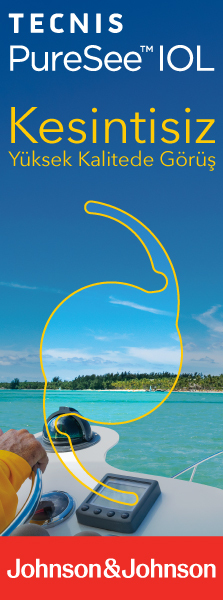TJ-CEO
2009 , Vol 4 , Num 1
Corneal Refractive Changes and Vector Analysis after Trabeculectomy
1Celal Bayar Üniversitesi, Göz Hastalıkları A.D., Manisa, Uzm. Dr.2Celal Bayar Üniversitesi, Göz Hastalıkları A.D., Manisa, Prof. Dr.
3Celal Bayar Üniversitesi, Göz Hastalıkları A.D., Manisa, Yard. Doç. Dr.
4Ege Üniversitesi, Göz Hastalıkları A.D., İzmir, Doç. Dr. Purpose: To evaluate the magnitude and time course of corneal refractive changes occuring in the cornea after trabeculectomy by means of keratometry and corneal topography.
Materials and Methods: Eighteen eyes of 21 patients who underwent trabeculectomy were prospectively analysed. Corneal refractive measurements were done with keratometry and corneal topography instruments besides intraocular pressure (IOP) measurements at 1 week, 1. month, 3. month and 6. month in all cases. Absolute astigmatism values, induced asigmatism values and with the wound components of astigmatism during these periods were determined by Eğrilmez’s “Vector Analysis Program” and recorded.
Results: The mean preoperative IOP was 30.8±8.9 mmHg, the mean postoperative IOP values at 1 week, 1. month, 3. month and 6.month were 9.7±4.4, 11.8±6.1, 14.1±6.9 and 14.3±6.1 mmHg, respectively (p<0.001). Mean keratometric values and mean Sim K values obtained were not statistically different between preoperative and postoperative periods (p>0.05). Vector analysis put forth with the wound type astigmatism at rates of 56%with topography and 76%with keratometry in the early postoperative period, most prominent at 1 week. With the wound astigmatism decreased after 1 wek, possibly due to loosening of sutures, and became similar to preoperative values at 6. month. Induced astigmatism seems stabile after the 3. month.
Concusions: Astigmatic changes appear after trabeculectomy, especially in the early period. However these changes are not reflected in keratometric mesaurements and Sim K values measured with topography. Induced astigmatism after trabeculectomy should be assessed with vector analysis method. The most possible reason for induced astigmatism detected in the early periods is tight suturing of flap causing decrease in radius of corneal curvature. Keywords : Astigmatism, corneal topography, keratometry, trabeculectomy, vector analysis





